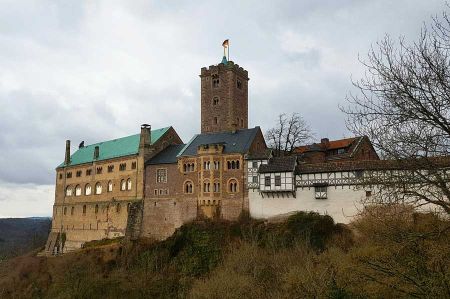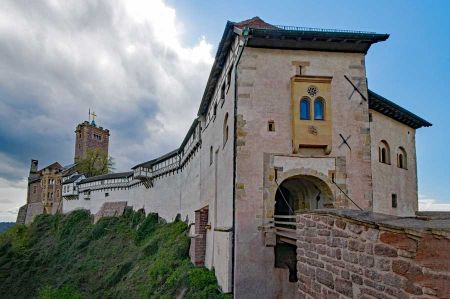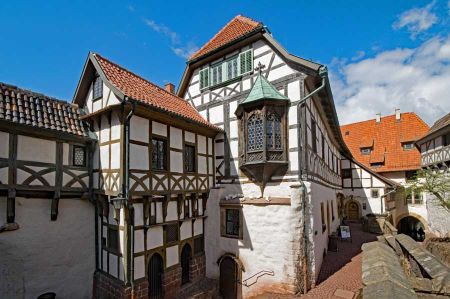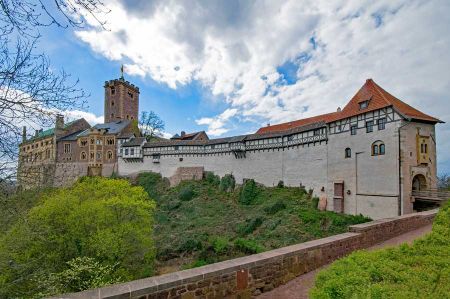The Wartburg near Eisenach - the myth about oath swords
- Written by Portal Editor
The Wartburg, located high above the city of Eisenach in Thuringia, is connected to the history of Germany like hardly any other castle in Germany.
The Wartburg was also one of our destinations, which we approached as part of a day excursion from Billroda. The Wartburg was founded by Ludwig the Springer around 1067, is a guard castle according to the name "Warte" and has been a UNESCO World Heritage Site since 1999. From 1211 to 1227 Elisabeth of Thuringia, who was later canonized, lived in the castle. In 1521/22 the reformer Martin Luther hid here as “Junker Jörg” and during this time he translated the New Testament of the Bible (“September Testament”) into German in just eleven weeks. We will report on this in more detail later. Johann Wolfgang von Goethe stayed here several times, for the first time in 1777. On October 18, 1817, on the occasion of the 300th anniversary of Martin Luther's theses (October 31, 1517) and in commemoration of the Battle of Leipzig (16. until October 19, 1813) the first Wartburg Festival took place at the castle. The second Wartburg Festival was held in the revolutionary year of 1848. So it is not surprising that the castle was already a national monument in the 19th century.
However, the current appearance of the Wartburg is largely to be understood as a new building from the 19th century including less preserved parts, which can be traced back to the Grand Duke Carl Alexander of Saxe-Weimar-Eisenach.
Legendary swords of the Wartburg
 The myth about the so-called "oath swords of the Wartburg" are part of the founding legend of the Wartburg in Thuringia. The discovery of these “oath swords” reported in 1845 is also considered a flimsy example of historical falsification. Apparently the find was so remarkable that in archeology the type of iron bar (Taleae ferreae) uncovered on the Wartburg is still referred to as the “oath sword” to this day.
The myth about the so-called "oath swords of the Wartburg" are part of the founding legend of the Wartburg in Thuringia. The discovery of these “oath swords” reported in 1845 is also considered a flimsy example of historical falsification. Apparently the find was so remarkable that in archeology the type of iron bar (Taleae ferreae) uncovered on the Wartburg is still referred to as the “oath sword” to this day.
According to the legend retold by Ludwig Bechstein, Count Ludwig der Springer was tricked into becoming the owner of the mountain on which the Wartburg was to be built.
It was Count Ludwig, the Springer, a powerful gentleman in Thuringia. When he once hunted on the Inselberg, he met a piece of game that he eagerly pursued, and rode after him as far as the Hörsel river, and as far as Nieder-Eisenach, and from there back to the mountain, on which the Wartburg now stands. There he stayed and wanted to wait where the game ran out of the forest, meanwhile looked at the beautiful area and especially the steep rocky mountain, and thought to himself and said: "Wait, Berg, you should become a castle for me!" Desire to build on the mountain, he sought ways and means to begin it properly, because the mountain belonged to the Lords of Frankenstein, who already owned a castle nearby, called the Mittelstein, (and this was the best before the Wartburg Castle in Thuringia,) but had their ancestral castle on the other side of the forest near Salzungen just above the Werra.
 And the count had with him twelve knights, brave free men, with whom he secretly consulted, / when they had found themselves with him, how he should take the mountain, and it was thus dealt that at night from the mountain of foam belonged to the count, earth was carried in baskets on the Wartberg and scattered on it, and the count then struck a truce by force, behind which he could defend himself. Soon the gentlemen of Mittelstein and Frankenstein came, but could not harm the count on his rock fortress, and therefore sued him with the emperor and the empire for violently presuming theirs. When asked by the empire, the count replied: he had built the castle on his own and, according to Urthel and right, he hoped, he wanted to keep it. Thereupon the empire recognized, if he could prove and swear with twelve honest men, with a bodily oath that the land on which he was built would be if he should keep it. Then the count chose his twelve knights to assist them, stepped up with them on the mountain, stuck their swords into the earth they had previously carried up and swore that their lord, Count Ludwig, would stand on his own, and that this soil (namely the one that was carried up) would stand on his old age ) belonged to the land and rule of Thuringia. With that he kept the mountain.
And the count had with him twelve knights, brave free men, with whom he secretly consulted, / when they had found themselves with him, how he should take the mountain, and it was thus dealt that at night from the mountain of foam belonged to the count, earth was carried in baskets on the Wartberg and scattered on it, and the count then struck a truce by force, behind which he could defend himself. Soon the gentlemen of Mittelstein and Frankenstein came, but could not harm the count on his rock fortress, and therefore sued him with the emperor and the empire for violently presuming theirs. When asked by the empire, the count replied: he had built the castle on his own and, according to Urthel and right, he hoped, he wanted to keep it. Thereupon the empire recognized, if he could prove and swear with twelve honest men, with a bodily oath that the land on which he was built would be if he should keep it. Then the count chose his twelve knights to assist them, stepped up with them on the mountain, stuck their swords into the earth they had previously carried up and swore that their lord, Count Ludwig, would stand on his own, and that this soil (namely the one that was carried up) would stand on his old age ) belonged to the land and rule of Thuringia. With that he kept the mountain.
The legend has been remembered as an example of medieval jurisprudence and Ludovingian family history.
The "Swords of Oath" bring restoration to light
 When the restoration of the castle began, up to three meters thick debris had to be removed from the two castle courtyards in order to expose the foundation walls and the castle rock. Grand Duke Carl Alexander von Sachsen-Weimar-Eisenach had commissioned the restoration of the Wartburg from 1835 and visited the construction site at regular intervals to find out about the progress of the work. During one such inspection in 1845, he was led to a crevice that had just been uncovered. Well moved, Carl Alexander was then able to help uncover a bundle of rusted iron parts with his own hands, which were referred to as the "oath swords of the Wartburg". Carl Alexander was fooled. Delighted about the authenticity of the legend, he had the swords deposited in a specially made display case in the Elisabethkemenate after they had been professionally cleaned and preserved. The fraud did not become apparent until after his death, when letters from archaeologists and archaeologists learned of similar finds in various parts of Germany. The true circumstances of the find later turned out to be a clever fake. The people involved in this forgery remained unknown. The motive was assumed to keep the Grand Duke weighed in order to provide further funds for the castle renovation. It would also be plausible to give the ducal family more prestige through this sensational find from the Wartburg.
When the restoration of the castle began, up to three meters thick debris had to be removed from the two castle courtyards in order to expose the foundation walls and the castle rock. Grand Duke Carl Alexander von Sachsen-Weimar-Eisenach had commissioned the restoration of the Wartburg from 1835 and visited the construction site at regular intervals to find out about the progress of the work. During one such inspection in 1845, he was led to a crevice that had just been uncovered. Well moved, Carl Alexander was then able to help uncover a bundle of rusted iron parts with his own hands, which were referred to as the "oath swords of the Wartburg". Carl Alexander was fooled. Delighted about the authenticity of the legend, he had the swords deposited in a specially made display case in the Elisabethkemenate after they had been professionally cleaned and preserved. The fraud did not become apparent until after his death, when letters from archaeologists and archaeologists learned of similar finds in various parts of Germany. The true circumstances of the find later turned out to be a clever fake. The people involved in this forgery remained unknown. The motive was assumed to keep the Grand Duke weighed in order to provide further funds for the castle renovation. It would also be plausible to give the ducal family more prestige through this sensational find from the Wartburg.
Origin of the oath swords from the Iron Age
 The "swords" found were later examined in detail by archaeologists and recognized as an Iron Age deposit. During these examinations it was found that two of the twelve swords that have survived were reproduced. In addition, the recovered find was held together with a wire, the metallurgical composition of which could not match the age of the find material.
The "swords" found were later examined in detail by archaeologists and recognized as an Iron Age deposit. During these examinations it was found that two of the twelve swords that have survived were reproduced. In addition, the recovered find was held together with a wire, the metallurgical composition of which could not match the age of the find material.
The other ten pieces of iron are from an Iron Age depot find, which is probably more than 1000 years older than the traditional founding date of the Wartburg. There is also no evidence whether the 10 iron bars come from the Wartburg or from a previously unknown site in Germany. The Siegerland is considered to be the production area for such goods.
Burg und Kaiserpfalz in der Kleinstadt Allstedt
Rentina Castle - Roman Via Egnatia towards Kavala
-
 Wartburg next to Eisenach - Luther
Wartburg next to Eisenach - Luther
Wartburg next to Eisenach - Luther
Wartburg next to Eisenach - Luther
-
 Wartburg next to Eisenach - Luther
Wartburg next to Eisenach - Luther
Wartburg next to Eisenach - Luther
Wartburg next to Eisenach - Luther
-
 Wartburg next to Eisenach - Luther
Wartburg next to Eisenach - Luther
Wartburg next to Eisenach - Luther
Wartburg next to Eisenach - Luther
-
 Wartburg next to Eisenach - Luther
Wartburg next to Eisenach - Luther
Wartburg next to Eisenach - Luther
Wartburg next to Eisenach - Luther
-
 Wartburg next to Eisenach - Luther
Wartburg next to Eisenach - Luther
Wartburg next to Eisenach - Luther
Wartburg next to Eisenach - Luther
-
 Wartburg next to Eisenach - Luther
Wartburg next to Eisenach - Luther
Wartburg next to Eisenach - Luther
Wartburg next to Eisenach - Luther
https://www.alaturka.info/en/germany/thuringia/5433-the-wartburg-near-eisenach-the-myth-about-the-oath-swords#sigProIdfaa391c1ee

